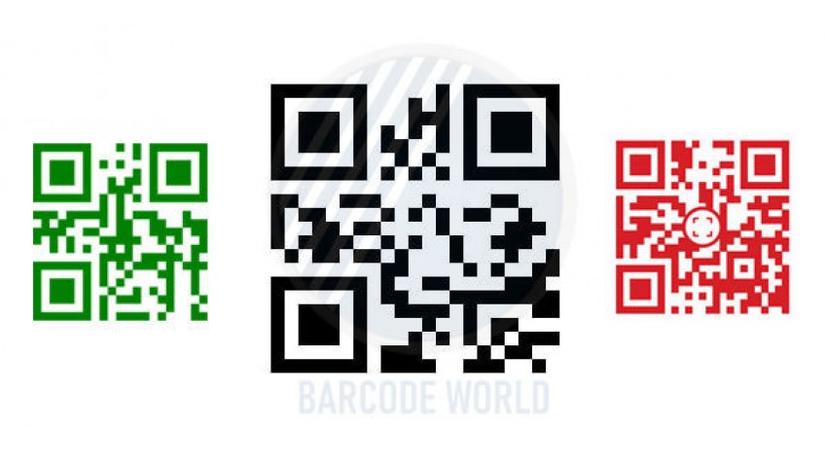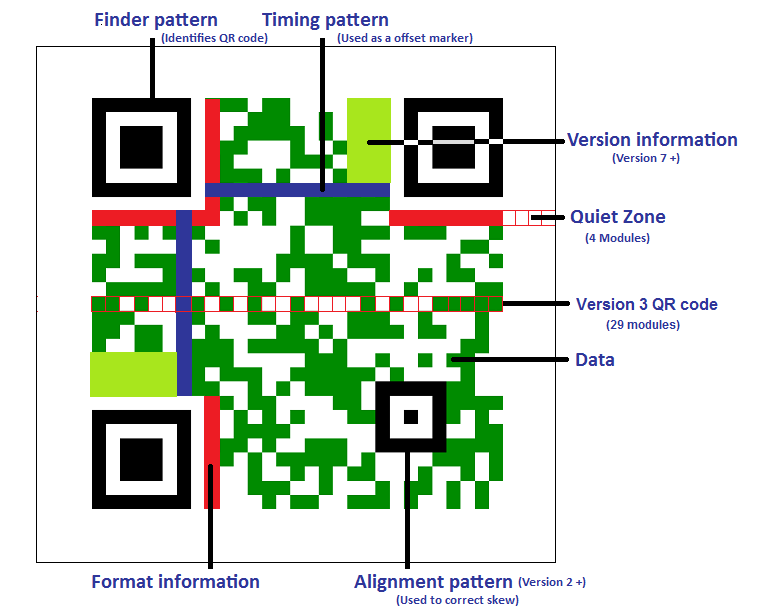
The following article briefly introduces QR codes
1. What is Quick Response code (QR Code)?
QR stands for Quick Response. This is a matrix code, also known as a two-dimensional bar code, which is used to provide easy access to information that can be read by a barcode reader or smartphone. The QR code consists of black modules randomly arranged in a square with a white background. The combination of these modules can provide a large amount of coding information for data such as links, documents or other data.
QR Code was built in 1994 by Denso Wave Company (Japan) with the aim of decoding fast matrix with high speed. Initially, the QR Code application was primarily used for inventory management in many different industries and was most used in Japan, but today its application is in almost every field and spread out. many countries in the world
The difference between traditional QR codes and barcodes is the amount of data they hold or share. Traditional bar codes have one-dimensional long lines and can only store up to 20 digits, while two-dimensional QR codes can store thousands of digits information because they can carry information. both vertically and horizontally. The QR code holds more information and the ease of use will be of great help to users in every field.
QR Code was developed to be able to read faster, saving time and space compared to traditional barcodes. For smartphones, you can search on the app store with the keyword “QR scanner” to download the QR Code scanning application.
Classify:
- Static QR codes, the most common type, are used to disseminate information to the public. They are often displayed in brochures, on television and in newspapers and magazines. Code generators can track information about the number of times the code has been scanned and the actions related to the code being executed, along with the scan time and the operating system of the scanned devices.
- Dynamic QR Codes (Unique QR Codes) provide more functions. Owners can edit the code at any time and may have different codes for each target audience. These codes can track more specific information, including scanner name and email address, the number of times they scan the code.
2. Method of creating QR codes
Technical data
- Standards: The standard standards for QR code symbol system are named JIS X 0510 (Japan) or ISO / IEC 18004 (International ISO Standards).
- Data capacity: A QR code can contain up to 7089 alphanumeric characters, 4296 alphanumeric characters, 2953 bytes or 1817 Kanji characters.
- Character set: The initial QR code defined JIS-8 / Shift-JIS is the default character set, the QR code standard since ISO / IEC 18004: 2006 defines Latin-1 as the default character set, the Mobile applications often use UTF-8 as the default, so it is up to the barcode reader to choose which character set to use.
- Error correction: QR codes provide integrated error correction based on Reed-Solomon algorithm. The supported levels are Low, Medium, Quartile, High. Depending on the level of error correction, it is possible to recover from 7% (Low) to 30% (High) of unreadable code words in the QR code symbol.
- QR code supports “Structured Append”. Max has 16 QR codes that can be linked together. If a scanner or decoder supports this feature, it will return the connected data content in the correct order.
- QR code printing quality: To optimize barcode quality, the QR code should not be printed with dots smaller than 4 to 5 pixels.
Compared to the 20-character alphanumeric limit of traditional barcodes, QR codes can contain thousands of data characters. Therefore, QR codes can be used to share multimedia content. QR codes can also direct the phone to perform certain actions (For example, a music program that can provide QR codes not only sends information about time, place, singer, but also Can embed date, time, and location information of upcoming shows into phone calendar
Data can be translated into QR codes through the QR code generator. Users enter the data they want the QR code to display and the creator makes it an icon. Currently, there are many applications to create QR codes for free. Just type the keyword “QR code generator” on the search engine you will find a lot of online tools to help create QR codes.
3. QR code structure
The QR code has a square structure, inside of black and white checkers interspersed. At first glance, we would expect these small squares to be randomly arranged. However, if you look closely at the QR code, you will see all the clutter that follows a certain structure. 
- Finder pattern – Indicates the direction when printing a QR code.
- Alignment symbol (Aglignment pattern) – This is an additional help QR code scanner easier when large code size.
- Timing patterns – These lines help the scanner accurately determine the size of the data.
- Version information – Specifies the version that the QR code currently in use in the 40 QR code versions currently available.
- Format information – Contains information about the data mask pattern and the fault tolerance of the code, making it easy to scan the code.
- Data and error correction key (Data) – This is the part containing actual data.
- Quiet zone – This is a dividing line that helps scanning devices distinguish the QR code from the environment outside the code.
4. Application of QR code
- URL storage: The phone simply reads the QR Code to get the URL, then automatically opens the browser.
- Used at bus, train and subway stations: Users who scan the QR Code of a bus stop will know information about the bus trips.
- Use at museums: Users only need to scan the QR code placed next to an exhibit to know detailed information and updates about the item.
- Used to purchase anywhere: Users when taking the subway, bus … if you like the item being advertised on it can be ordered immediately via QR Code and
- Use at supermarkets: For information, cooking instructions as well as the nutritional content of foods to buy.
- Use at seminars, presentations, events: Participants can use QR Code instead of their Business Card.
- Use at festivals, live shows, bars, clubs: To determine whether the item, the singer, the band, the current song, the song’s author.
- Use at restaurants, hotels, coffee shops: To know the recipes and how to prepare food, drinks, hotel information.
- Use with personal items (Car, T-shirt …): Provide detailed information about the item, origin, price.
…
QR codes are more and more widely used because they have many outstanding advantages over traditional barcodes :
- High capacity – Store more data, allow real content to be stored and not just IDs or references.
- Requires less space – Get the same data stored on a much smaller surface area.
- Resistance to dust and damage – Even if damaged, there is a chance they can still be read.
- Readable from any direction – Scanning them from any angle, the reader need not align in the direction of the code.
- Extra structure – Data that can be divided into multiple codes when scanned can be combined to reproduce the original content.
